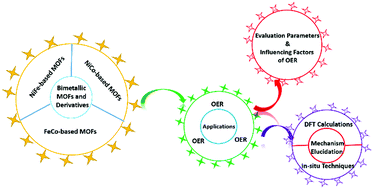Transition metal-based bimetallic MOFs and MOF-derived catalysts for electrochemical oxygen evolution reaction
Abstract
The oxygen evolution reaction (OER) is a critical electrochemical reaction in water splitting and rechargeable metal–air batteries. It plays a pivotal role in achieving high-efficiency clean-energy production and energy storage in these devices. Transition metal-based bimetallic MOFs (TMB MOFs) with two different metal ions possess specific synergistic effects, which could exhibit OER performance and stability superior to those of the corresponding monometallic MOFs for water oxidation. Benefiting from the diversity of chemical composition and structural type, TMB MOFs can also serve as precursors and templates to obtain alloy-particle-decorated carbon materials with high surface area, or metal compounds such as bimetallic sulfides, phosphides, and hydroxides with atomic-level mixing of heterometallic elements. These materials with high-density active sites exhibit much improved catalytic activity in the water oxidation reaction. This article aims to review the recent progress with TMB MOFs and their derivatives in relation to applications as electrocatalysts in OER, including analysis of the mechanism of the OER process with the assistance of DFT calculations and in situ or operando techniques.



 Please wait while we load your content...
Please wait while we load your content...